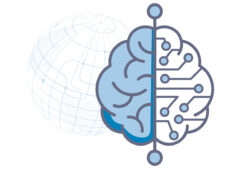The Next Frontier in Healthcare?
Of all the technologies expected to transform healthcare over the next decade, blockchain may be the one many industry leaders find the most puzzling. Like with interoperability, artificial intelligence (AI) and machine learning, there’s no shortage of hype about the distributed ledger technology, including conferences and consortiums devoted to exploring its potential for revolutionizing how providers, payers and patients manage and share healthcare data.
What exactly is blockchain? Many hospital leaders automatically associate it with the ransomware attacks they’ve been struggling to fend off from hackers who demand the digital currency bitcoin in exchange for stolen patient information held hostage. Though blockchain technology was initially developed a decade ago to power the exchange of bitcoin, its capabilities extend well beyond the cryptocurrency itself.
How Blockchain Works
Blockchain is a technology that stores and secures transactional data through a distributed ledger composed of encrypted blocks. Records are shared across a network of synchronized, replicated databases rather than a centralized one. These records are visible to credentialed users who may add to the transactions they are given access to—but not alter or delete anything. Each transaction is verified collectively among users and recorded chronologically across the network, forming an immutable chain.
The decentralized structure of the blockchain is designed to not only make data sharing more transparent and collaborative, but also to make it safer through its built-in trust protocol. Each block in the chain is secured by a time-stamped digital wax seal in the form of a cryptographic hash, which references the hash of the previous block. This makes the ledger virtually tamper-proof, because no block in the chain can be hacked without simultaneously hacking every other block before it.
Retail, financial services and supply chain industries are already deploying this technology for several reasons. It enables them to replace clunky, tedious record-keeping systems with the automated, real-time systems many customers crave. The technology also helps eliminate the cost and friction that come with relying on intermediaries to process and reconcile data on the back end.
What Blockchain Means for Healthcare
With all of the complexity, mandates and privacy concerns in healthcare, many are skeptical about whether blockchain would actually work for payers and providers. But a growing contingent of industry leaders see promise in the technology for alleviating some of the biggest challenges of managing healthcare data, including improving the accuracy and security of patient records and the interoperability of systems.
The crux of blockchain’s potential for healthcare is its capability for helping clinicians share patient data seamlessly and expeditiously both internally and with physicians and specialists outside hospital systems, says Ed Hickey, former assistant vice president of clinical data and analytics for HealthTrust.
“That’s where this has immediate value, because you can share information with other organizations instantaneously and securely without exposing any private health records,” Hickey says.
Currently, critical information about individual patients tends to be scattered across an assortment of records maintained by different providers, with few of the records actually validated against each other. This often results in incomplete, inaccurate data that can easily be duplicated, or in a worst-case scenario, potentially jeopardize a patient’s health. Records are also fragmented and disorganized due to the lack of common architecture and different interpretations of standards across electronic health record (EHR) software and other clinical systems. Disparities throughout systems make it hard to share and access vital patient records when they are needed most.
Organizations abound with “siloed, sequestered pieces of information that make it difficult to tie all of the details in the medical record together as a patient moves within or outside of a healthcare system,” Hickey says. Exchanging data across healthcare systems is still very much a manual process fraught with vulnerabilities.
With its distributed ledger, blockchain could help bind disparate information together more effectively and ensure that all stakeholders see, validate and confirm the details. The framework of the technology also provides multiple checkpoints for evaluating the consistency, integrity and security of patient data with each block added to the chain.
As a result of data breaches caused by increasingly bolder and more sophisticated cyber criminals, hospitals are more focused on protecting patient information. Records in a blockchain model would allow users to authenticate certain details without disclosing all of the information in the chain. Blockchains can also be public or private. For example, hospitals could limit a blockchain network to only HIPAA-covered entities through software programs such as smart contracts, which would require users to complete certain verification steps before exchanging and accessing information.
Healthcare executives find blockchain most appealing for its ability to facilitate transactions directly without requiring an intermediary. Not only could sharing ledgers help organizations cut costs, but it could also make data more transparent for all stakeholders. Blockchain would create a permanent record of activity users could access—a reality not currently possible because so many transactions are processed by third-party companies with little incentive to share data. Instances of fraud cost the industry millions of dollars each year, so the transparency and security advantages of blockchain could help reduce fraud as well as the risks that arise from single points of failure.
Financial & Supply Chain Potential
Proponents of blockchain believe the technology in its current form is best-suited to straightforward transactions that demand a high degree of trust and security, such as claims processing and billing. It has the potential to simplify and accelerate the process for submitting claims for patients and negotiating contracts with payers.
“Blockchain could eliminate a lot of today’s manual activities and provide hospitals with more immediate status updates,” Hickey says. “The technology enhances the security of assets moving through the supply chain, while also providing better visibility and tracking throughout the life cycle for products such as implants, medical devices and pharmaceuticals.”
Innovators are also exploring the potential of blockchain for advancing drug development, medical research, master patient indexes and population health initiatives. Not only could the technology create opportunities for improving patient care and safety, but it may eventually give patients more control over their own health data by enabling them to set parameters around who can access information in their medical records.
Challenges to Blockchain Adoption
Though blockchain poses exciting possibilities for helping hospitals achieve interoperability, cut costs and administrative time, and provide more patient-focused care, it’s not a panacea for all of the challenges healthcare leaders face.
The technology is still emerging and would require organizations to agree upon standards for how data on the blockchain would be used and shared. This is already an obstacle for many current technologies in place. The technology would also disrupt existing IT systems and require organizations to revamp much of their current technological architecture, as well as their process for sending, receiving and storing data. The time and costs it would require might be more than some leaders are willing to take on at the moment.
Due to mandates and privacy rules, organizations would also need to be able to ensure that sensitive information on the blockchain would be secure from hackers, which would likely require some additional investment in cybersecurity. Some also question whether patients would be willing to accept ownership over their health records on the blockchain—and the role providers would need to play in the oversight.
The technology would “introduce new processes and protocols that would need to be managed and accounted for, and that could cause disruption,” Hickey says.
Because hospital leaders must balance new care delivery and payment models they are working to adopt, and deal with all of the financial and regulatory pressures, many are unsure how blockchain would fit into their operations. Unless the technology is tied to mandates or incentives, cultural adoption will likely be difficult to achieve, Hickey adds.
Successful implementation of blockchain in any organization will also hinge on how many other providers and payers are equipped to utilize the technology.
Hospital leaders can prepare for the upcoming blockchain revolution by educating themselves on what the technology might mean for their health system and other industry partners. Blockchain isn’t going away anytime soon, so the sooner hospitals can deepen their understanding of it, the better positioned they’ll be to reap its benefits.
According to Kent Petty, former chief information officer for HealthTrust, “We’ve got to start building bench strength around the skills blockchain will require and understanding this technology better. Despite blockchain’s promise, there are still a lot of questions to consider, including: How do we invest in blockchain in a way that unlocks its potential?”
Share Email AI, Cybersecurity, Information Technology, Q3 2018





